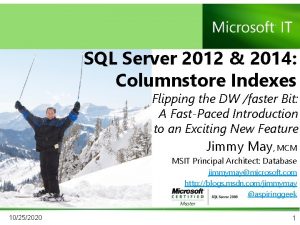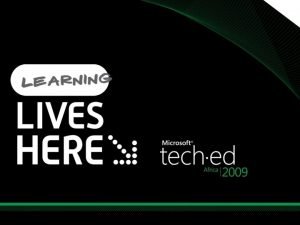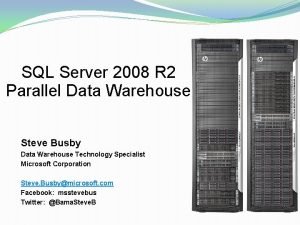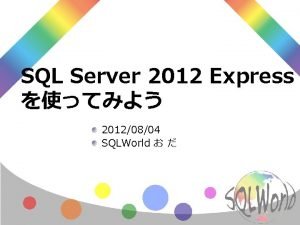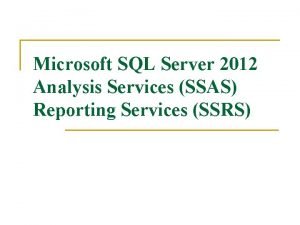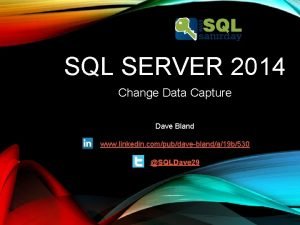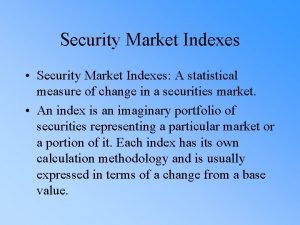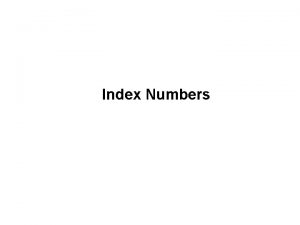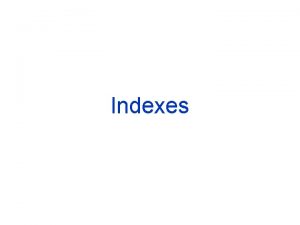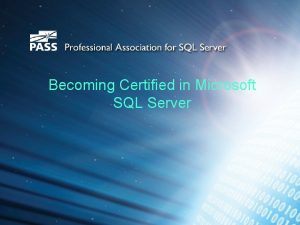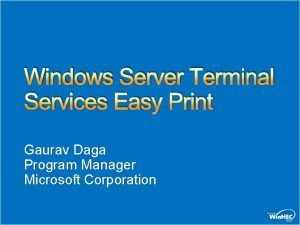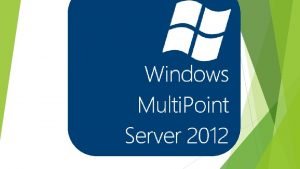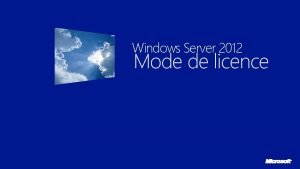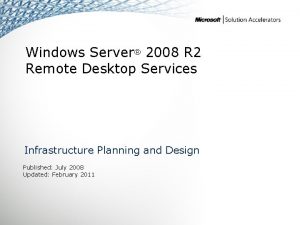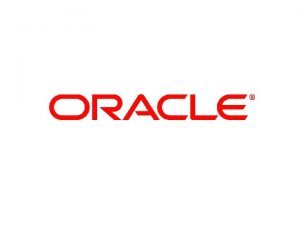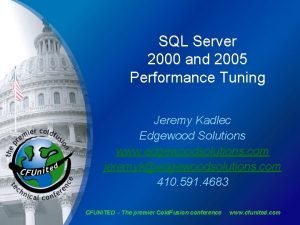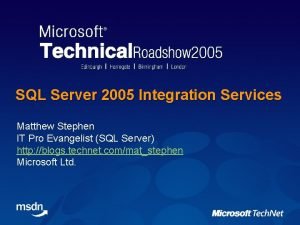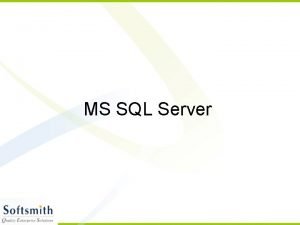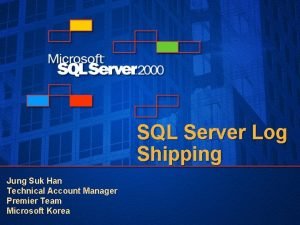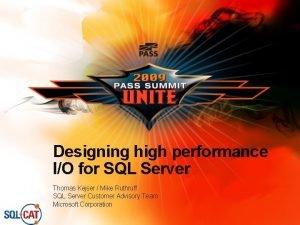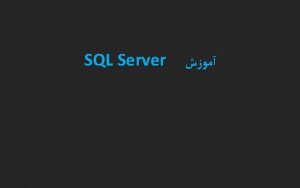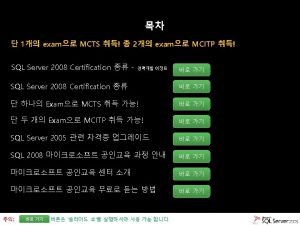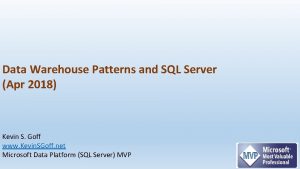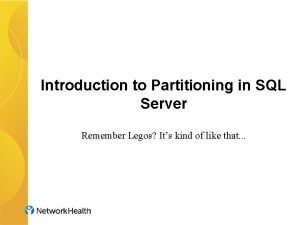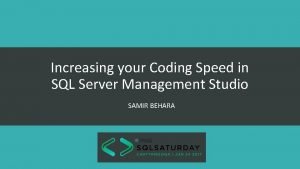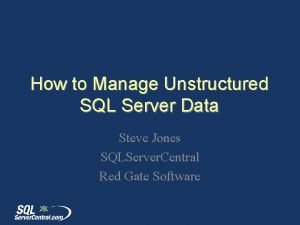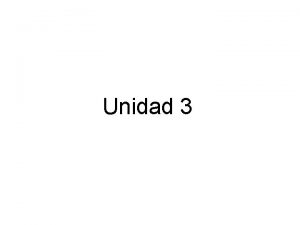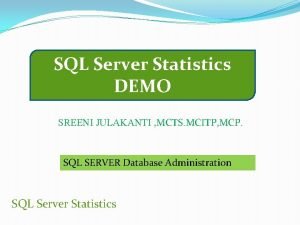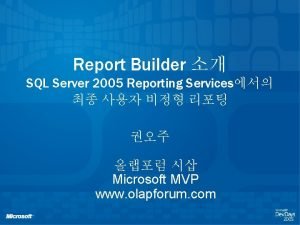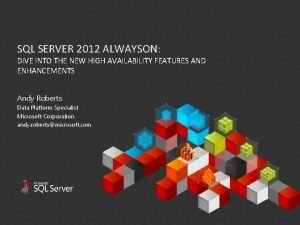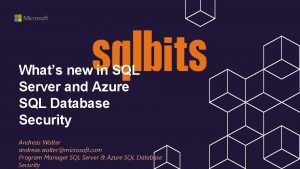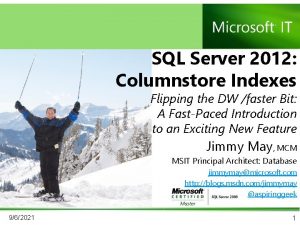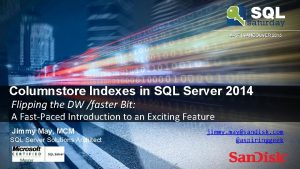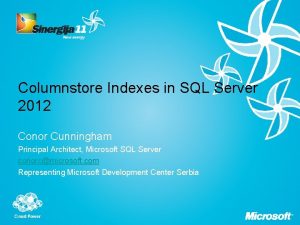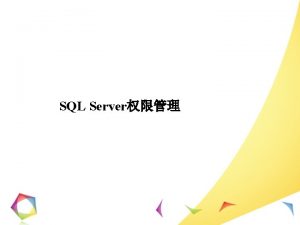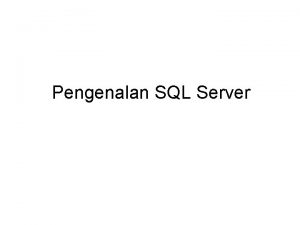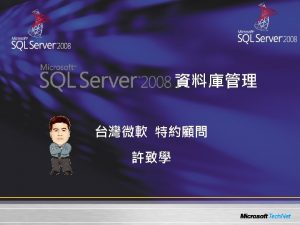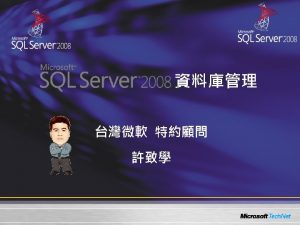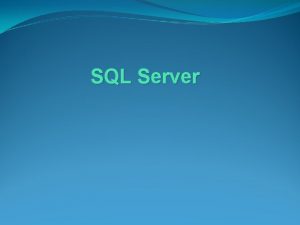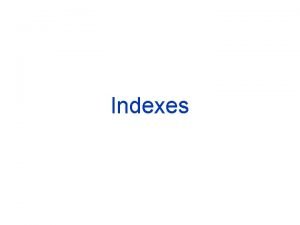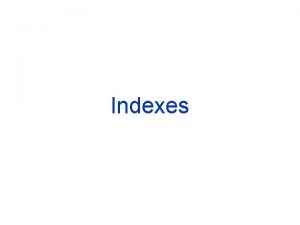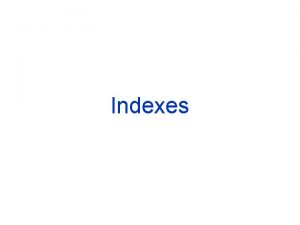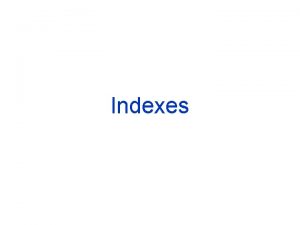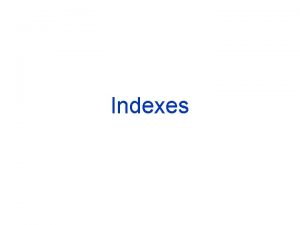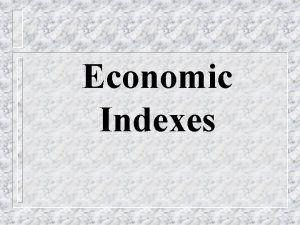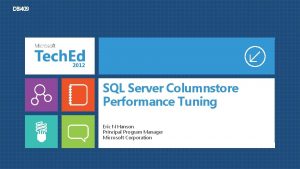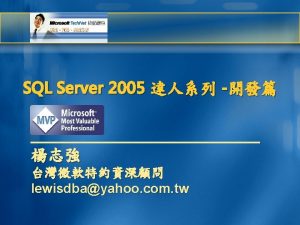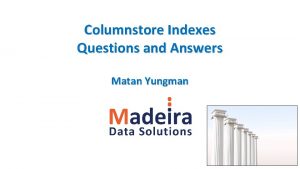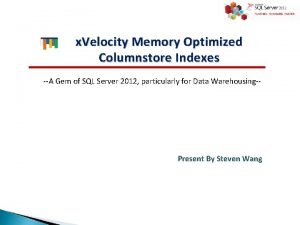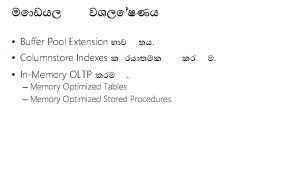SQL Server 2012 2014 Columnstore Indexes Flipping the



















































- Slides: 51

SQL Server 2012 & 2014: Columnstore Indexes Flipping the DW /faster Bit: A Fast-Paced Introduction to an Exciting New Feature Jimmy May, MCM MSIT Principal Architect: Database jimmymay@microsoft. com http: //blogs. msdn. com/jimmymay @aspiringgeek 10/25/2020 1

Shahry Hashemi, Wingman @dsfnet http: //dsfnet. blogspot. com 2

Bio Jimmy May, MCM MSIT Principal Architect: Database Formerly: Sr. Program Manager, SQL CAT SQL Server Customer Advisory Team Microsoft Certified Master: SQL Server (2009) MS IT Gold Star Recipient (2008) Microsoft Oracle Center of Excellence (2008) SQL Server MVP Nominee (2006) Indiana Windows User Group www. iwug. net Founder & Board of Directors Indianapolis Professional Association for SQL Server www. indypass. org Founder & Member of Executive Committee SQL Server Pros: Founder & Visionary-in-Chief SQL Innovator Award Recipient (2006) Contest sponsored in part by Microsoft Formerly Chief Database Architect for high-throughput OLTP VLDB at Exact. Target (recently IPO) Senior Database Administrator for Open. Globe/Escient jimmymay@microsoft. com www. twitter. com/aspiringgeek http: //blogs. msdn. com/jimmymay

C: >sqlservr. exe /faster 4

Agenda 1. Introduction 2. SQL Server 2012: New, Improved Features! 3. SQL Server 2014: New, Improved Features! 4. Columnstore Indexes 1. Overview 2. Architecture 3. Scenarios 4. More Info 5

Agenda 1. Introduction 2. SQL Server 2012: New, Improved Features! 3. SQL Server 2014: New, Improved Features! 4. Columnstore Indexes 1. Overview 2. Architecture 3. Scenarios 4. More Info 6

Agenda 1. Introduction 2. SQL Server 2012: New, Improved Features! 3. SQL Server 2014: New, Improved Features! 4. Columnstore Indexes 1. Overview 2. Architecture 3. Scenarios 4. More Info 9

What is a SQL Columnstore Index? q Codename Apollo q Part of “x. Velocity” in-memory family of technologies Common codepath with Verti. Paq § Power. Pivot, Power. View, SSAS § q Contrasted with traditional row stores in which data is physically stored row-by-row q Columnstores values for all rows for a given column 10

Columnstore High-Level Characteristics q Highly compressed q Aggressive readahead q In-memory structures q Processes data in units called "batches“ q Vector-based query execution q Query Optimizer automatically considers columnstore indexes during compilation q Numerous deep engine modifications § I/O, Memory, & Caching 11

Why Use Columnstore Indexes? q Designed to optimize access to large DWs (vs. OLTP) § Star schema, large fact tables (esp. integer keys), aggregations, scans, reporting q Faster, interactive query response time q Transparent to the application § Most things “just work” Backup and restore § Mirroring, log shipping § SSMS, etc. § There are some gotchas (stay tuned…) § 12

Why Use Columnstore? (cont. ) q Reduced physical DB design effort § Fewer (or no!) conventional indexes § Reduced need for summary aggregates and indexed views § May eliminate need for OLAP cubes q Lower TCO § Yes, I had to say this! 13

Star Schema Fact. Sales ( Customer. Key int , Product. Key int , Employee. Key int , Store. Key int Dim. Employee , Order. Date. Key int , Sales. Amount money ) --note: lots of ints in fact tables Dim. Customer ( Customer. Key int , First. Name nvarchar(50) , Last. Name nvarchar(50) , Birthdate , Email. Address nvarchar(50) ) Dim. Store Dim. Product (… Fact. Sales Dim. Date Dim. Customer

Gotchas q Some queries, even the schema might have to be modified to fully leverage q Read only, not writable § For today q Work-around: “Trickle-loading” § Large fact table § New data is loaded in real-time in smaller staging table § Query via UNION ALL q Enterprise Edition only q Not yet available in Azure q Not compatible with indexed views, filtered indexes, sparse columns, computed columns q Datatype support significant but not complete 15

Syntax Similar to Existing DML CREATE NONCLUSTERED COLUMNSTORE INDEX ix_cs_My. DWTable ON dbo. My. DWTable (col 1 , col 2 , . . . , coln); CREATE CLUSTERED COLUMNSTORE INDEX ix_cs_My. DWTable ON dbo. My. DWTable; --no column list! DROP INDEX dbo. My. DWTable. ix_cs_My. Table; ALTER INDEX dbo. My. DWTable. ix_cs_My. Table DISABLE; ALTER INDEX dbo. My. DWTable. ix_cs_My. Table ENABLE; 16

Hints to Force / Prevent Usage q Force the Optimizer to use: …FROM dbo. My. DWTable WITH (INDEX (ix_cs_My. Table))… q Prevent the Optimizer from using: SELECT… FROM dbo. My. DWTable WHERE… GROUP BY… ORDER BY… OPTION (IGNORE_NONCLUSTERED_COLUMNSTORE_INDEX); 17

Agenda 1. Introduction 2. SQL Server 2012: New, Improved Features! 3. SQL Server 2014: New, Improved Features! 4. Columnstore Indexes 1. Overview 2. Architecture 3. Scenarios 4. More Info 18

19 How Do Columnstore Indexes Optimize Perf? … C 1 C 2 C 3 C 4 q Heaps, B-trees store data row-wise q Columnstore indexes store data column-wise § Each page stores data from a single column q Highly compressed § § About 2 x better than PAGE compression More data fits in memory q Each column accessed independently § § Fetch only needed columns Can dramatically decrease I/O

20 Columnstore Index Architecture Segment C 1 C 2 C 3 C 4 C 5 C 6 q Row Group § 1 million logically contiguous rows q Column Segment § § Row Group § § § Segment contains values from one column for a set of rows Segments for the same set of rows comprise a row group Segments are compressed Each segment stored in a separate LOB Segment is unit of transfer between disk and memory

21 Columnstore Index Example Order. Date. Key Product. Key Store. Key Region. Key Quantity Sales. Amount 20101107 106 01 1 6 30. 00 20101107 103 04 2 1 17. 00 20101107 109 04 2 2 20. 00 20101107 103 03 2 1 17. 00 20101107 106 05 3 4 20. 00 20101108 106 02 1 5 25. 00 20101108 102 02 1 1 14. 00 20101108 106 03 2 5 25. 00 20101108 109 01 1 1 10. 00 20101109 106 04 2 4 20. 00 20101109 106 04 2 5 25. 00 20101109 103 01 1 1 17. 00

22 Horizontally Partition (Row Groups) Order. Date. Key Product. Key Store. Key Region. Key Quantity Sales. Amount 20101107 106 01 1 6 30. 00 20101107 103 04 2 1 17. 00 20101107 109 04 2 2 20. 00 20101107 103 03 2 1 17. 00 20101107 106 05 3 4 20. 00 20101108 106 02 1 5 25. 00 Order. Date. Key Product. Key Store. Key Region. Key Quantity Sales. Amount 20101108 102 02 1 1 14. 00 20101108 106 03 2 5 25. 00 20101108 109 01 1 1 10. 00 20101109 106 04 2 4 20. 00 20101109 106 04 2 5 25. 00 20101109 103 01 1 1 17. 00

23 Vertically Partition via Columns (Segments) Order. Date. Key Product. Key Store. Key 20101107 106 01 20101107 103 04 20101107 109 04 20101107 103 03 20101107 106 05 20101108 106 02 Order. Date. Key Product. Key Store. Key 20101108 102 02 20101108 106 03 20101108 109 01 20101109 106 04 20101109 103 01 Region. Ke y Quantity 1 1 2 2 2 3 1 Region. Ke y 1 2 2 1 6 2 1 4 5 Quantity 1 5 1 4 5 1 Sales. Amoun t 30. 00 17. 00 20. 00 25. 00 Sales. Amoun t 14. 00 25. 00 10. 00 25. 00 17. 00

24 Compress Each Segment* Order. Date. Key Product. Key Store. Key Region. Key Quantity Sales. Amount 20101107 106 01 1 6 30. 00 04 2 1 17. 00 20101108 103 109 03 2 05 4 5 02 20. 00 25. 00 Order. Date. Key Product. Key Store. Key Region. Key Quantity Sales. Amount 20101108 102 02 1 1 14. 00 03 2 5 25. 00 20101109 106 109 01 103 04 4 10. 00 25. 00 17. 00 Some segments will compress more than others *Encoding and reordering not shown

25 Fetch only needed columns SELECT Product. Key, SUM (Sales. Amount) FROM Sales. Table WHERE Order. Date. Key < 20101108 GROUP BY Product. Key Store. Key Region. Key Quantity 01 1 6 04 2 1 3 2 03 Order. Date. Key Product. Key Sales. Amount 20101107 106 30. 00 103 17. 00 109 20. 00 20101108 25. 00 4 05 5 02 Store. Key Region. Key Quantity Order. Date. Key Product. Key 02 1 1 20101108 102 03 2 5 20101109 106 01 04 4 109 103 Sales. Amount 14. 00 25. 00 10. 00 25. 00 17. 00

Columnstore in SQL 2014 q Fully Read/Write! § Far more transparency to the app than ever § No need for “trickle-loading” or other workarounds q Data type support expanded: § All data types except: CLR, (n)varchar(max), varbinary(max), XML, Spatial § Basically, SQL 14 columnstore is compatible with all non-blob datatypes 26

Columnstore in SQL v. next (cont. ) q New: Clustered Columnstore § Dependency on conventional b-tree structures has been removed § Potential for significant disk space savings if workload is satisfied without conventional indexes q Note: Non-clustered columnstore remains a read-only structure § Required if: § Constraints are required § Workload requires b-tree non-clustered indexes 27

Columnstore in SQL v. next (cont. ) q “Batch mode”: § Query Processor vector-based (L 1 cache resident) operations expanded, improved § New support for: • All joins (including OUTER, HASH, SEMI (NOT IN, IN) • UNION ALL • Scalar aggregates • “Mixed mode” plans q Improvements to bitmap, spill support, etc. 28

Agenda 1. Introduction 2. SQL Server 2012: New, Improved Features! 3. SQL Server 2014: New, Improved Features! 4. Columnstore Indexes 1. Overview 2. Architecture 3. Scenarios 4. More Info 29

Scenarios q Columnstore Index DDL Demo q Customer: Motricity: Case Study q MSIT SONAR App: Aggregations § booyah! q Customer: Dev. Con Security: Production App § double-booyah! q MSIT Problem Management App § triple-booyah! q But, we still have room for improvement… 30

Columnstore Index DDL: Demo 31

SQL CAT Customer: Motricity q Sybase customer q Demographic data & app required columnstore capabilities q Proved out technology on Denali bits q Numerous learnings discovered & incorporated into SQL Server 2012 RTM q Production implementation leveraged partitioning & “trickle loading” (& Always. On Availability Groups) q Case Study: http: //www. microsoft. com/casestudies/Microsoft-SQL-Server -2012 -Enterprise/Motricity/Mobile-Advertiser-Makes-Gainswith-Easy-Migration-of-Sybase-Database-to. Microsoft/710000000170 q Customers: @armpitslinky, @SQLJack. Burton, & the cuddliest customer ever in the SQL CAT Lab: @dsfnet 32

MSIT SONAR App Po. C Logical Reads CPU Durn 160, 323 20, 360 9, 786 9, 053, 423 549, 608 193, 903 x 56 x 27 x 20 (8 K pages) Columnstore Conventional Table & Indexes Δ (ms) Metrics (Δ) Conventional vs. Columnstore Metrics 60 10, 000 (ms) x[VALUE] 9, 000 50 8, 000 7, 000 40 6, 000 30 5, 000 x[VALUE] 4, 000 x[VALUE] 20 3, 000 2, 000 10 1, 000 - Logical Reads (data pages) CPU (ms) Durn (ms) 33

Customer: Dev. Con Security: Production App q Revenue History Fact Table q Table stats 22 M rows § 137 columns § 33 GB data § q Indexing strategery challenging, especially for ad hoc queries 34

Customer: Dev. Con Security: Production App: SSRS q Scenario 1: SSRS § Before: SSAS cube processing + batch process ran MDX to dump results into a separate table § “…hassle to maintain” q Before: Queries against conventional table structures: § 10 - 12 seconds q After: Queries against Columnstore: § 1 second § One order of magnitude faster 35

Customer: Dev. Con Security: Production App: Ad Hoc Queries q Scenario 2: Ad Hoc Queries q Before: Queries took 5 – 7 minutes q After: Columnstore: 1 – 2 seconds § Two orders of magnitude faster 36

Customer: Dev. Con Security: Production App: Outcomes q Unsolicited feedback: § “What we found was pretty awesome. ” § “It has been a game changer for us in terms of the flexibility we can offer people that would like to get to the data in different ways. ” — Nathan Allphin, BI Team Lead q Customer is deprecating this aspect of their SSAS infrastructure in favor of columnstore 37

MSIT Problem Management App q Interactive app for which queries returned results in unpredictable time frame: “ 2 – 7 minutes” q Wide table: 151 columns all commonly subject to interrogation § § DB Dev troubleshooting time & expertise scarce Indexing strategery difficult/impossible q Table stats 3. 1 M rows § 15 GB data (barely fits in memory; lots of churn) § 1. 7 M data pages q Columnstore index: 478 pages (memory resident) § 38

MSIT Problem Management q How to index a table with these columns? Ticket. Folder. ID, Module. Name, Module. Sub. Type, Ticket. ID, Created. Date, Created. By. Alias, Created. By. Full. Name, Created. By. Location. Country, Created. By. Location. City, Created. By. Location. Building, Source, Contact. Type, Contact. Alias, First. Name, Last. Name, Email, Business. Customer, Contact. Location. Country, Contact. Location. City, Contact. Location. Building, Contact. Location. Alt. Country, Contact. Location. Alt. City, Contact. Location. Alt. Building, Asset. Type, Asset. Service, Service. Category, Asset. Name, Asset. Model 1, Asset. Description, Asset. Manufacturer, Asset. Make 1, State, Status, Summary, Impact, Urgency, Priority, Contact. Reason, Details, Environment. Specific, Scheduled. Date, Current. L 1, Current. L 2, Current. L 3, Current. Group. ID, Current. Group, Current. Sub. Group. ID, Current. Sub. Group, Current. Team. ID, Current. Team, Current. Individual, Assigned. To. Name, SLADeadline, Resolved. At. Date, Response. Deadline, Responded. At. Date, Affected. Service, Requested. Service, Resolution. Category, Close. Details, Final. Status, Failure. Impact, Service. Outage, CIOutage, KBArticle. Action, KBArticle. Title, KBArticle. ID, Resolved. By. Alias, Resolved. By. Full. Name, Resolved. By. Location. Country, Resolved. By. Location. City, Resolved. By. Location. Building, Resolved. By. Employee. Type, Resolved. By. Company, Major. Incident. Review. Date, Major. Incident. Review. Outcome, Addl. Contacts, On. Behalf. Of, Original. Priority, Original. Service. Category, Original. Asset. Type, Original. Asset. Service, Original. Asset. Name, Original. Asset. Model, Original. Asset. Description, Original. Asset. Manufacturer, Original. Contact. Reason, Original. L 1, Original. L 2, Original. L 3, Original. Group. ID, Original. Group, Original. Subgroup. ID, Original. Subgroup, Original. Team. ID, Original. Team, Original. Individual, Alt. Telephone, Alt. Location, Location. Type, Ticket. Location, Reactivation. Reason, Closed. Date, Email. Sent. To. Queue. Date, First. Non. Auto. Response. Act. Type, First. Escalation. L 1 to. L 2 Flag, First. Escalation. L 1 to. L 2 Date, L 2 Escalation. Group. ID, L 2 Escalation. Group, L 2 Escalation. Subgroup. ID, L 2 Escalation. Subgroup, L 2 Escalation. Team. ID, L 2 Escalation. Team, L 2 First. Non. Auto. Response. Date, L 2 First. Non. Auto. Response. Activity, First. Escalation. L 2 to. L 3 Flag, First. Escalation. L 2 to. L 3 Date, L 3 Escalation. Group. ID, L 3 Escalation. Group, L 3 Escalation. Subgroup. ID, L 3 Escalation. Subgroup, L 3 Escalation. Team. ID, L 3 Escalation. Team, L 3 First. Non. Auto. Response. Date, L 3 First. Non. Auto. Response. Activity, Third. Party. Pend. Status. Duration, Third. Party. Reference, Last. Updated. Date, Pending. Closure, Third. Party. Name, Third. Party. Other, Sub. Group. Transfer. Flag, Sub. Group. Response. Deadline, Sub. Group. Response. Date, Primary. Config. Folder. ID, Service. Config. Folder. ID, KBArticle. Details, Cluster. Nodes, Resolvable. By. Previous. Team, Resolve. Comments, Client. Pending. Status. Duration. Min, Parts. Pending. Status. Duration. Min, Contact. Job. Title, KBArticle. Category, KBType, KBNotes, Met. Communication, Avg. Communication. Time 39

Typical Query --Current. Group, Current. Sub. Group, Module. Name SELECT TOP 10 Current. Group, Current. Sub. Group, KBArticle. Title, COUNT(*) as Row. Cnt FROM dbo. ITSM 01 ISRM WHERE Current. Group = 'Ex. D Services' AND Created. Date > dateadd(dd, -30, getdate()) AND Current. Sub. Group = 'SAP' AND Status = 'Resolved' GROUP BY Current. Group, Current. Sub. Group, Module. Name ORDER BY COUNT(*) DESC --OPTION (IGNORE_NONCLUSTERED_COLUMNSTORE_INDEX); 40

Query Duration used to be Unpredictable But Columnstore renders consistent subsecond results Duration (minutes) 10: 00 8: 37 9: 00 8: 00 7: 00 6: 00 5: 00 4: 00 3: 00 2: 00 1: 00 0: 00 2: 33 2: 27 1: 06 1: 37 0: 35 0: 00 B-Tree Test B-Tree Test Columnstore #1 #2 #3 #4 #5 #6

y tle Ti le tic Ar KB or eg at n am t. T e en lu tio n. C so Re rr Cu so ea t. R nt ac y rit io Pr n tio l Em ai ip cr es t. D Co se As ce ur So e am e. N ul od M Conventional vs. CS Perf: Duration 250, 000 Duration (ms) 200, 000 150, 000 100, 000 Conventional CS 50, 000 0 42

y tle Ti le tic Ar KB or eg at n am t. T e en lu tio n. C so Re rr Cu y rit so ea t. R nt ac Co io Pr l n tio ip cr es t. D se As 1, 000 Em ai ce ur So e am e. N ul od M Conventional vs. CS Perf: Logarithmic Duration (ms) 100, 000 1, 000 Conventional CS 100 10 43

y tle Ti le tic Ar KB or eg at n am t. T e en n. C lu tio so Re rr Cu y rit so ea t. R nt ac Co io Pr l n tio ip cr es t. D se As 1, 000 Em ai ce ur So e am e. N ul od M Conventional vs. CS Perf: I/O (8 KB data pages) 100, 000 10, 000 Conventional 1, 000 CS 100 10 44

or y tle Ti le tic Ar KB eg at am n so t. T e en lu tio n. C so Re rr Cu y rit io ea t. R nt ac Co Pr n tio l Em ai 100, 000 ip cr es t. D se As ce ur So e am e. N ul od M Conventional vs. CS Perf: CPU (ms) 10, 000 1, 000 CPU (ms) Conventional 100 CPU (ms) CS 10 45

Columnstore Indexes: Room for Improvement… 46

Best Practices q Create CS indexes on “large” fact tables q Leverage “star joins” § Joins on integer keys q Inner Join, Group By, Aggregations q Include all columns of eligible datatypes q Leverage Parallelism q Provide sufficient memory q Use in conjunction with partitioned tables 47

Key Learnings q q Some specific considerations in 2012 : § Read-only—for now (see references for Trickle Loading implementation) § Filtering optimizations in the storage engine are limited to numeric data types § Using OR statements in predicates results in less efficient plan vs. what is generated for row based indexes § Some OUTER JOINs § Large number of joins results in inability to use batch mode processing § Joining on string data types does not push bitmap filtering down into the storage engine § Optimizer may not optimize UNION ALL § Data type support is extensive but incomplete NOTE: Significant improvements are implemented in SQL Server v. next

Key Learnings (cont. ) q Query performance of columnstore indexes is good, even great—once you have the “right” plan & can leverage batch mode q Able to meet/beat competitors in terms of performance; however query rewrite and schema changes may be required q To get full parallelism of column store index builds may require significant memory grants. This can be problematic on wide or string heavy tables. § q Parallelism on index build is not support if table has < 1 million rows. Always. On availability groups work well for many DW workloads § Able to keep up with expected bulk load rates and columnstore index builds § Observed some upper limits on the “bytes per second” to the replica in the 40 MB/s*. This caused the replica to fall behind for regular index build scenarios and more intensive loads. *Under review with development team

Agenda 1. Introduction 2. SQL Server 2012: New, Improved Features! 3. SQL Server 2014: New, Improved Features! 4. Columnstore Indexes 1. Overview 2. Architecture 3. Scenarios 4. More Info 51

Columnstore Indexes: More Info The following is a must-read: SQL Server Columnstore Index FAQ Eric Hanson, Susan Price, etc. http: //social. technet. microsoft. com/wiki/contents/articles/3540. sql-server-columnstoreindex-faq-en-us. aspx Microsoft Internal: SQL 14 What's new with Always. On and Column Store Indexes Other references: Forthcoming: My blog http: //blogs. msdn. com/jimmymay Columnstore Indexes http: //msdn. microsoft. com/en-us/library/gg 492088(SQL. 110). aspx SQL Server Columnstore Performance Tuning http: //social. technet. microsoft. com/wiki/contents/articles/4995. sql-server-columnstore-performance-tuning. aspx Trickle Loading with Columnstore Indexes http: //social. technet. microsoft. com/wiki/contents/articles/trickle-loading-with-columnstore-indexes. aspx How do Column Stores Work? Thomas Kejser http: //blog. kejser. org/2012/07/04/how-do-column-stores-work This is Columnstore – Part 1 Gavin Payne, MCM http: //gavinpayneuk. com/2012/07/22/this-is-columnstore-part-1 Saturday Keynote: Inside SQL Server 2012’s Columnstore Index http: //sqlbits. com/Sessions/Event 10/Saturday_Keynote 52

Q-&-A 53

Acknowledgements q Susan Price, SQL Server PM (former) q Eric Hansen, SQL Server PM q Gus Apostol, SQL Server PM q Thomas Kejser, Fusion-io CTO (former SQL CAT PM) q Mike Ruthruff, Engineer, Bungie Studios (former SQL CAT PM) q Gavin Payne, MCM, Coeo Consultant q Steve Fisher, MSIT Senior Service Engineer 54
 Sql server columnstore index best practices
Sql server columnstore index best practices Sql server 2005 management studio
Sql server 2005 management studio Ms sql dts
Ms sql dts Parallel data warehouse sql server 2012
Parallel data warehouse sql server 2012 Sql server 2012 express
Sql server 2012 express Sql server analysis services 2012
Sql server analysis services 2012 Sys.sp_cdc_add_job
Sys.sp_cdc_add_job Flipping bits in memory without accessing them
Flipping bits in memory without accessing them The probability of sandy flipping
The probability of sandy flipping What is security market index
What is security market index Sys.partitions
Sys.partitions Miller indices 2d
Miller indices 2d Laspeyres price index
Laspeyres price index Clusttered
Clusttered Security market indicator series
Security market indicator series Blue chip derivatives
Blue chip derivatives Productivity index
Productivity index Indexes scales and typologies
Indexes scales and typologies Npv profile calculator
Npv profile calculator The logical view
The logical view Sql certification microsoft
Sql certification microsoft Terminal services easy print
Terminal services easy print Windows multipoint server 2012
Windows multipoint server 2012 Windows server 2012 essentials launchpad download
Windows server 2012 essentials launchpad download Windows server 2012 r2 essentials
Windows server 2012 r2 essentials Eol windows server 2012
Eol windows server 2012 Remote desktop virtualization host role server 2012
Remote desktop virtualization host role server 2012 Difference between oracle and pl sql
Difference between oracle and pl sql Sql developer unit test
Sql developer unit test Sql server 2005 performance tuning
Sql server 2005 performance tuning Ssis sql server 2005
Ssis sql server 2005 Microsoft sql server introduction
Microsoft sql server introduction Sql server 2005 sp
Sql server 2005 sp Access sql sorgu örnekleri
Access sql sorgu örnekleri How to monitor log shipping in sql server 2005
How to monitor log shipping in sql server 2005 High performance sql server
High performance sql server Sql server service broker tutorial
Sql server service broker tutorial Tsql
Tsql Sql server 2008 certification
Sql server 2008 certification Mssql regexp_like
Mssql regexp_like How to populate fact table sql server
How to populate fact table sql server Sql server vertical partitioning
Sql server vertical partitioning Sql server management studio recover unsaved queries
Sql server management studio recover unsaved queries Varbinary in sql server
Varbinary in sql server Cursor fast forward sql server
Cursor fast forward sql server Sql server
Sql server Sql server
Sql server Reporting services 2005
Reporting services 2005 Visio sql
Visio sql Sql server always on architecture diagram
Sql server always on architecture diagram Azure sql advanced threat protection
Azure sql advanced threat protection Sql server 2000 sp
Sql server 2000 sp
